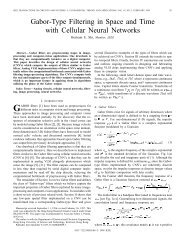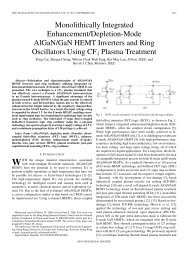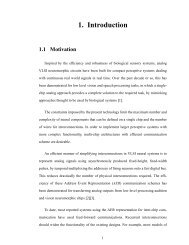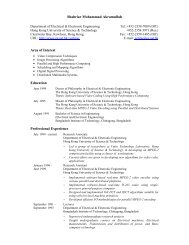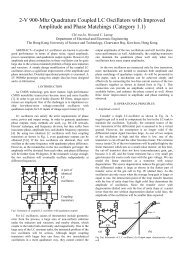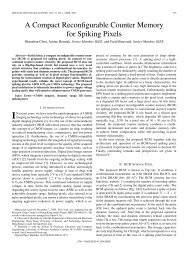4 BEE TRANSACTIONS ON COMMUNICATIONS, VOL. 38, NO. 1, JANUARY 1990I n.CODED CHANNELFig. 1.DECODERDiscrete-time model.OT k=l 1 k.2 27 k=3 37 k.4 47 k.5 57Fig. 2. Simple eight-state <strong>trellis</strong>.corresponding to sequence x then has a cumulative metric r that isthe sum <strong>of</strong> the metrics <strong>of</strong> its branches.XU. PROPOSED DECODING ALGORITHMAn optimal ML decoder chooses the path through the <strong>trellis</strong> frominitial state SO having the best (minimum) metric as defined above.The Viterbi algorithm recursively implements this exhaustive searchby maintaining one survivor path to each state in the <strong>trellis</strong> at eachtime kT. That survivor is the path <strong>with</strong> minimum metric over allpaths that can reach the state. We can avoid this exhaustive approachby discarding paths at any depth k in the <strong>trellis</strong> that have a “high”metric and are therefore unlikely to be the transmitted path. Sincepath metrics will accumulate <strong>with</strong> time, we cannot simply comparepath metrics to a fixed threshold. Introducing a threshold <strong>with</strong> a biasthat increases <strong>with</strong> depth in the <strong>trellis</strong> is one possibility. Such a biasis incorporated into path metrics [8] for depth-<strong>first</strong> and metric-<strong>first</strong><strong>decoding</strong> [3] to allow comparisons between paths at different depths.Such an approach does, however, require knowledge or estimates<strong>of</strong> the channel signal-to-noise ratio. Also, the bias is selected foraverage channel noise; when noise is high, all paths will tend toincrease their metrics and look poor. A better approach may be tosample the prevailing noise conditions by using the metric <strong>of</strong> +e bestpath in contention. The resulting simple discard rule ise discardpathiattimekTifri-rB >Twhere r B is the metric <strong>of</strong> the best path at depth k, and Tis a fmedthreshold. Note that the choice <strong>of</strong> the lowest metric for subtractionmaximizes the metric differences and will therefore minimize thenumber <strong>of</strong> paths which survive the rejection tests.To complete the <strong>decoding</strong> algorithm, it is necessary to specifyhow a decoded output is obtained from the list <strong>of</strong> survivor paths.Where the paths all merge to a common history (see Fig. 3) thedecoder output path is simply the common section. More precisely,the commoxt branch symbol for time (k -L)T is released where L isthe <strong>decoding</strong> depth. It is possible that the paths will not have mergedby this depth, and this may be quite common when higher rejectionthresholds are used. Clearly, the best strategy in this situation is (asin a Viterbi algorithm implementation) to take the decoder decisionpath branch to be that belonging tb the path in storage having thelowest metric, that is, the path <strong>of</strong> highest likelihood. All unmergedpaths are then rejected.Fig. 3.o*aaa* TRANSMIT PATH m- ALTERNATE PATH m’Typical contender paths.A formal statement <strong>of</strong> the recursive algorithm for time kT is thefollowing.1) Extend each survivor from (k- 1)T into b contenders, concatenatingthe new symbol to the path history and updating theaccumulated path metric <strong>of</strong> each contender.2) Find and mark the contender having best metric I?,.3) Subtract I?, from the metric <strong>of</strong> each contender and compare tothreshold T, marking those that fail the test for rejection.4) Mark for rejection all contenders whose path history symbolsat (k- L)T do not agree <strong>with</strong> that <strong>of</strong> the best path.5) Purge all contenders marked for rejection to form the new survivorlist at time kT.Note that the subtraction <strong>of</strong> rB normalizes all path metrics so thatmetric overflow is really not a problem. Note also that since pathstates do not enter into the path-rejection processing, it is possiblethat distinct survivors may share a common state at time kT. In thismode <strong>of</strong> operation, the decoder views the <strong>trellis</strong> as a tree, and isunaware <strong>of</strong> the concept <strong>of</strong> path states. This mode <strong>of</strong> operation hasbeen deliberately chosen. It would have been possible to implementan additional rejection step to purge all but the path <strong>of</strong> lowest metricin any group <strong>of</strong> paths that share a common state, as does theViterbi algorithm. For example, to discover which contender pathshave common states, an efficient approach would be to sort all thepaths by state. Such sorting, however, represents extra work, and
SIMMONS: BREADTH-FIRST TRELLIS DECODING5requires extra hardware in order to be accomplished <strong>with</strong> any sort <strong>of</strong>parallelism. In addition, simulations have shown that only marginalreductions in the average number <strong>of</strong> survivors can be gained by performingthe extra stateduplication purging.Note that step 4) above is eliminated from some reducedcomputationalgorithms, the justification being that its inclusion givesonly negligible performance improvement. Step 4) cannot be elmhatedhere however, as it compensates for not checking for stateduplications in the survivor list. If such paths are not eventuallyeliminated, they can cause the size <strong>of</strong> the survivor list to grow continually,<strong>with</strong> no corresponding increases in algorithm error-rate performance.Since any paths that rejoin to a common state must havediverged at some earlier time, step 4) will discover this divergenceand discard the poorer <strong>of</strong> such paths. State duplicating paths aretherefore still eliminated, but only after some delay needed for theirinitial divergence to appear in the path histories at depth L. It shouldbe emphasized that all bounding and simulation results shown laterinclude this effect, as it is an inherent part <strong>of</strong> the algorithm definedabove.There is another important consideration. Because the survivornumber ST is variable, it may at times tend to grow quite large. Theremust be some limit enforced on ST in a practical implementation. A“s<strong>of</strong>t” limit is proposed where iterative reprocessing <strong>with</strong> tightenedthresholds is performed until the tentative number <strong>of</strong> survivors isequal to the limit SL . The most efficient exact implementation <strong>of</strong> thiss<strong>of</strong>t-limiting is a binary search for the threshold that gives exactly SLsurvivors. An inexact but simpler implementation, and the methodadopted for the results shown later, is to reduce the threshold by 10percent at each reprocessing step until SL or fewer paths remain.No matter what method is used, s<strong>of</strong>t-limit reprocessing will increasethe average computational load. As long as SL is sufficiently high,however, this limiting operation will occur only infrequently, andcan contribute negligibly to the average computation. This is evidentin the later discussion <strong>of</strong> the results.IV. PERFORMANCE ANALYSISThe error-rate measure <strong>of</strong> interest is defined to be the time-averageper-symbol probability <strong>of</strong> an error event starting. The average number<strong>of</strong> survivors is taken as a measure <strong>of</strong> computational complexity.Upper bounds on these quantities are produced. The maximum number<strong>of</strong> survivors is not a relevant criterion where survivor numberlimiting will ultimately be applied. In addition, for some signal structuresthe upper bound on this maximum is bL, which will almostalways be too large to be useful.An error event will be defined by the divergence <strong>of</strong> the decoderdecision path from the transmitted path m (m stands for message).The probability <strong>of</strong> this occurring is <strong>of</strong> interest here; the number <strong>of</strong>symbol errors and the length <strong>of</strong> the error event are not <strong>of</strong> concern.It is assumed that the decoder knows the initial state <strong>of</strong> the coder orchannel.Rejection <strong>of</strong> the transmitted path is a necessary and sufficient conditionfor an error event to begin. Rejection <strong>of</strong> the transmitted pathcan occur only due to a failed threshold test or a forced decisionat <strong>decoding</strong> depth L. ’Qpical paths in contention are shown in Fig.3. An invocation <strong>of</strong> stationarity and ergodicity coupled <strong>with</strong> a standardunion bound argument (see Appendix A) allows the followingensemble-average upper bound on rejection probability PR :r 1where all transmitted paths m, and alternate (contending) paths m’,are confined to the interval [0, LT]; I represents divergence depth;P(m) is the probability <strong>of</strong> message m; and PI and Pf are used todenote threshold-test and forceddecision probabilities for a singlealternate m’. This is simply a summation over all possible alternatepaths that could become the best path and lead to rejection <strong>of</strong> thetransmitted path. The probability <strong>of</strong> error in a block <strong>of</strong> N symbolswould then be given by NPR . The defining probabilities for Pt andPf areP,(m’Im) = P[rm - rm, > TI and Pf (m’lm) = P[rm - rml L 01.Explicit expressions for PI and Pf for the BSC and AWGN channelscan be found in Appendix B. A very similar form can be constructedto bound the Viterbi algorithm error-rate. For the Viterbi algorithmbound, only those paths m’ that rejoin the state <strong>of</strong> the transmittedpath at time LT are counted, and these paths are considered to beinvolved in a metricdifference test <strong>with</strong> the transmitted path <strong>with</strong> aneffective threshold T <strong>of</strong> zero.The above bound result is based on a long-time average. fir theproposed algorithm, there will be a transient startup period for k < Lin any real transmissions where the probability <strong>of</strong> an event startingis somewhat lower than the long-time average. This is because <strong>of</strong> theinformation provided by the known start state; fewer alternate pathsare initially in contention. Similarly, if known information symbolsU* are inserted into the data stream (a useful strategy described later),the decoder using this information lowers PR for some intervals.Ignoring these two effects clearly produces an overbound on theaverage error event rate PE.The following bound on average number <strong>of</strong> survivors, conditionedon the tmnsmittadpth m king on the contender I&, can alsobe produced (see Appendix A):m m’where P,(rn’lm) denotes the conditional survival probability for m’and is given byP,(m’Jm) = P[rml - rm I TI.The bound’s <strong>first</strong> term is simply a summation over all alternate paths<strong>with</strong> weighting by the probability that the path would survive a thresholdtest in which rm replaces r,. Explicit expressions for P, for theBSC and the AWGN channel can be found in Appendix B.Conditioning the bound on the transmitted path being on the contenderlist is not a drawback if the primary concern is the probability<strong>of</strong> an error event starting, as is assumed. Naturally, the speed <strong>of</strong>the decoder implementation will be tailored for the average survivornumber occurring in the absence <strong>of</strong> errors, that is, <strong>with</strong> the transmittedpath present. If the transmitted path has already been rejected, thebound may then not hold, but the behavior <strong>of</strong> the survivor number inthis case is unimportant. Even if ST should grow uncontrollably andquickly reach an enforced limit SL , the decoder action can only resultin a longer event, not a new event. It should also be mentioned herethat the above bound has been developed assuming the decoder doesnot enforce a limit on the number <strong>of</strong> survivors. In the presence <strong>of</strong>limiting, the average number is actually found to decrease, as mightbe expected, at the expense <strong>of</strong> incurring extra computations neededto perform the limiting.V. BOUND EVALUATIONS AND SIMULATIONSThe bound expressions above require for a given transmitted pathm that all alternate paths m’ <strong>of</strong> length L symbols be explored. Sincethe constituent probabilities depend only on distance d(m, m’) [Euclidianor Hamming] for the AWGN or BSC channels, this evaluationmay be done by counting paths at each discrete value <strong>of</strong> distanced(m, m‘), and summing the contributions over all these distances.This path distance enumeration can be done <strong>with</strong>out redundant pathtracing by combining path counts where paths enter a common <strong>trellis</strong>state, and share a common distance d(m, m‘). A form <strong>of</strong> <strong>trellis</strong>“search” to depth L accomplishes this.One immediate problem is that the number <strong>of</strong> discrete values <strong>of</strong>d(m, m’) may be very large. To deal <strong>with</strong> this problem, a distanceboundary ds was defined that separated paths into “low” and “high”(3)(4)(5)



